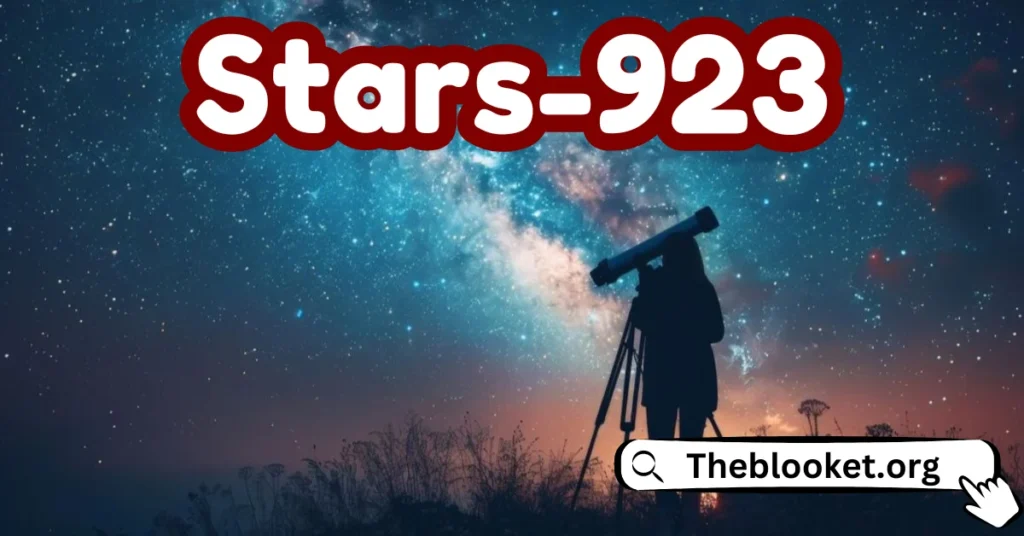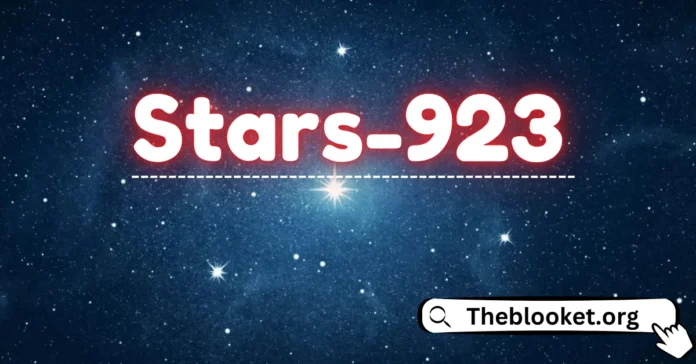Introduction
In the huge expanse of our universe, every superstar holds a story of its own, offering clues about the cosmic tactics that shape the very material of our existence. Among these celestial narratives, Stars-923 has emerged as a mainly interesting concern of study. Discovered within the constellation of Lyra, this megastar system has captivated astronomers with its unique residences and potential for groundbreaking discoveries. As we delve into the characteristics, importance, and recent studies on Stars-923, we uncover now not only the secrets of this distant star but also gain a deeper know-how of stellar evolution and the mysteries of our universe. This complete manual objective is to light up the captivating global of Stars-923, losing light on its function inside the broader context of astrophysical studies.
What is Stars-923?

Stars-923 is a noteworthy superstar system placed about 1,000 mild-years away within the constellation of Lyra. It is classed as a primary-series big name with a spectral type of F7V, distinguishing it from our Sun with its slightly higher temperature and luminosity. This star is famous for its white-yellow hue with a floor temperature of around 6,500 Kelvin. Although its distance makes direct commentary hard, its awesome characteristics have made it a high candidate for examination. Stars-923’s significance extends beyond its bodily houses because it serves as a precious challenge to knowledge of stellar evolution and the potential presence of exoplanets. Its discovery and subsequent analysis provide an essential window into the life cycle of comparable stars and the dynamics of stellar structures.
Key Characteristics
- Type and Classification: Stars-923 is classed as a main-sequence star with a spectral type of F7V. This type indicates that it is barely warmer and more luminous than the Sun. With a surface temperature of about 6,500 Kelvin, Stars-923 shines with a white-yellow light, distinguishing it from cooler, redder stars and warmer, bluer stars. Its position at the Hertzsprung-Russell diagram shows it is in a solid phase of its stellar existence cycle, where it steadily fuses hydrogen into helium in its middle.
- Size and Mass: Stars-923 has a predicted mass of about 1.Five times that of the Sun and a radius about 1.2 instances larger. These measurements imply that its miles are truly bigger and more expansive than our Sun, contributing to its expanded luminosity. The greater mass and length affect its gravitational forces and luminosity, which might be critical elements in expertise in its lifecycle and potential interactions with surrounding celestial objects.
- Age and Lifecycle: At around 4 billion years old, Stars-923 is considered middle-elderly for a star of its kind. This age places it in a stable section of its important-sequence life, where it has been fusing hydrogen for a large period and will continue to do so for several billion greater years. Studying its age and lifecycle facilitates astronomers to infer the evolutionary direction of comparable stars and expect their destiny degrees, including their eventual transition to crimson giant repute.
- Magnetic Activity: Observations have discovered that Stars-923 exhibits periodic versions in brightness, that are regularly connected to magnetic activity and the presence of starspots. These versions offer precious insights into the famous person’s magnetic area dynamics and how they affect typical behavior and emissions. Understanding those styles is important for modeling stellar magnetic interest and its consequences on nearby exoplanets.
- Potential for Exoplanets: Stars-923 has been identified as a key candidate in the look for exoplanets. Its strong characteristics and nicely described residences make it a great concern for detecting planetary systems. Preliminary records advise the opportunity of an orbiting exoplanet, although similar observations are had to affirm its presence and characteristics. Discovering exoplanets around Stars-923 may provide large insights into planetary formation and the conditions that could guide life.
Significance of Stars-923

Stars-923 holds a giant cost within the field of astronomy for numerous reasons. Its type as an F-kind principal-series megastar offers important insights into the lifecycle and evolutionary patterns of stars with similar mass and temperature. Studying Stars-923 facilitates astronomers to refine models of stellar evolution, mainly the transition phases main to the red giant degree. Additionally, the famous person’s strong characteristics make it a super candidate for the search for exoplanets. Discovering planets around Stars-923 may want to enhance our know-how of planetary formation and the capability habitability of worlds in comparable stellar environments. Furthermore, observations of Stars-923 contribute to the broader study of stellar magnetic pastime and phenomena, together with stellar flares, supplying a deeper comprehension of ways such activities have an impact on their environment and the cosmos.
Recent Research and Discoveries

- Magnetic Activity and Stellar Variability: Recent observations of Stars-923 have highlighted its magnetic pastime, glaring via periodic versions in brightness. These fluctuations are attributed to starspots and magnetic fields that affect the famous person’s luminosity. Advanced imaging strategies, consisting of excessive-decision photometry and spectroscopy, have been used to look at those variations, providing precious facts at the big name’s magnetic discipline dynamics. These studies are vital for knowing the interplay between magnetic interest and stellar conduct.
- Potential Exoplanet Detection: Stars-923 has been a focal point within the look for exoplanets, thanks to its solid and nicely-characterized residences. Preliminary radial velocity measurements suggest the presence of a capacity exoplanet orbiting the famous person. These findings, although now not yet confirmed, have spurred similar investigations of the usage of both ground-primarily based and space telescopes. Future observations intend to validate the exoplanet’s existence and decide its characteristics, consisting of its length, orbit, and ability habitability.
- Spectroscopic Analysis: Detailed spectroscopy of Stars-923 has supplied insights into its chemical composition and atmospheric residences. Analysis of absorption lines has found the presence of diverse elements, including iron, magnesium, and calcium, which enables researchers to apprehend the big name’s formation records and evolutionary stage. This data is critical for building correct fashions of stellar atmospheres and evaluating them with theoretical predictions.
- Stellar Atmosphere Studies: Recent research has targeted the stellar environment of Stars-923, inspecting its temperature, density, and chemical composition. This study is crucial for refining models of stellar atmospheres and knowledge of the physical approaches going on inside the superstar. By evaluating located statistics with theoretical models, scientists can benefit from insights into the complicated interactions among specific layers of the famous person’s environment.
- Stellar Evolution Insights: The records gathered from Stars-923 have contributed to broader information on stellar evolution, especially for F-kind principal-sequence stars. Research into its age, mass, and luminosity provides treasured statistics about the lifecycle of comparable stars and their future evolution. These insights assist astronomers expect how such stars will develop through extraordinary degrees, together with their eventual transition to the crimson massive section.
Conclusion
Stars-923 stands as a testimony to the ongoing exploration and discovery within the field of astronomy. Its unique characteristics, including its spectral classification and capacity for hosting exoplanets, offer vast insights into the lifestyle cycle and evolution of stars. As studies maintain and observational technology advances, our expertise of Stars-923 will possibly deepen, revealing even more approximately its role inside the cosmos. For both newbie astronomers and pro researchers, Stars-923 represents a captivating opportunity to explore the wonders of the universe and contribute to the ever-expanding knowledge of stellar phenomena. In unraveling the mysteries of this distant big name, we not only decorate our hold close of personal celestial objects but also gain a broader angle at the complicated and dynamic nature of the cosmos.
FOLLOW US



